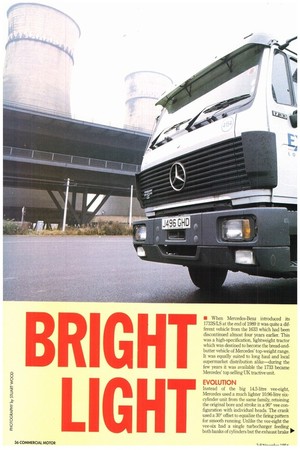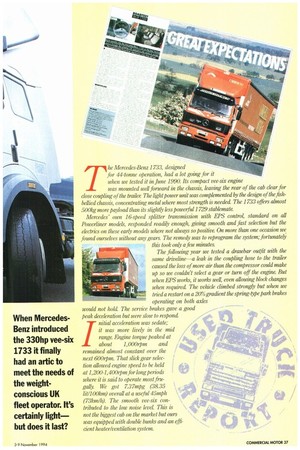BRIG
Page 38

Page 39

If you've noticed an error in this article please click here to report it so we can fix it.
LIGHT
• When Mercedes-Benz introduced its 1733S/IS at the end of 1989 it was quite a different vehicle from the 1633 which had been discontinued almost four years earlier. This was a high-specification, lightweight tractor which was destined to become the bread-andbutter vehicle of Mercedes' top-weight range. It was equally suited to long haul and local supermarket distribution alike—during the few years it was available the 1733 became Mercedes' top selling UK tractive unit
EVOLUTION
Instead of the big 14.5-litre vee-eight, Mercedes used a much lighter 10.96-litre sixcylinder unit from the same family, retaining the original bore and stroke in a 90° vee configuration with individual heads. The crank used a 30° offset to equalize the firing pattern for smooth running. Unlike the vee-eight the vee-six had a single turbocharger feeding .._ both banks of cylinders but the exhaust brake P
he Mercedes-Benz 1733, designed for 44-tonne operation, had a lot going for it when we tested it in June 1990. Its compact vee-six engine was mounted well forward in the chassis, leaving the rear of the cab clear for close coupling of the trailer The light power unit was complemented by the design of the fishbellied chassis, concentrating metal where most strength is needed The 1 733 offers almost 500kg more payload than its slightly less powetful 1 729 stablemate.
Mercedes' own 16-speed splitter transmission with EPS control, standard on all Potverliner models, responded readily enough, giving smooth and fast selection but the electrics on these early models where not always so Positive On more than one occasion we found ourselves without any gears. The remedy was to reprogram the system; fortunately this took only a few minutes.
The following year we tested a drawbar outfit with the same driveline—a leak in the coupling hose to the trailer caused the loss of more air than the compressor could make up so we couldn't select a gear or turn off the engine But when EPS works, it works well, even allowing block changes when required The vehicle climbed strongly but when we tried a restart on a 20% gradient the spring-type park brakes operating on both axles would not hold. The service brakes gave a good peak deceleration but were slow to respond
Initial acceleration was sedate; it was more lively in the mid range Engine torque peaked at about 1,000rpm and remained almost constant over the
next 600rpm. That slick gear selection allowed engine speed to be held at 1,200-1,400rpm for long periods where it is said to operate most frugally. We got 73 7mpg (38.35 lit/100km) overall at a useful 45mph
































































































